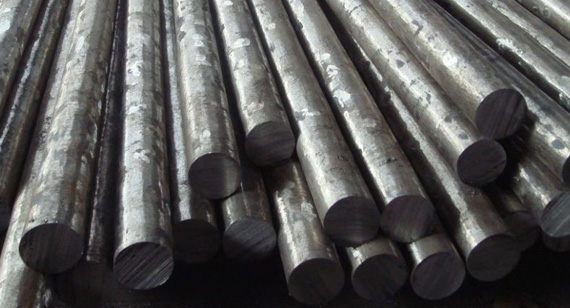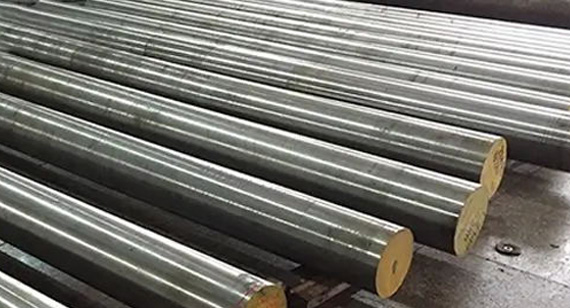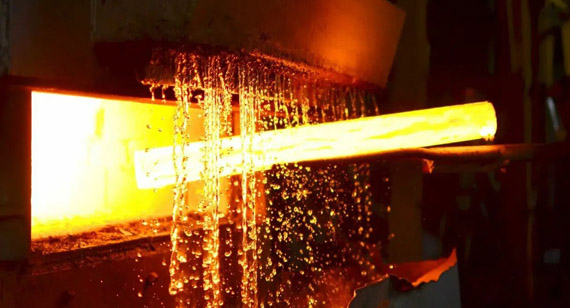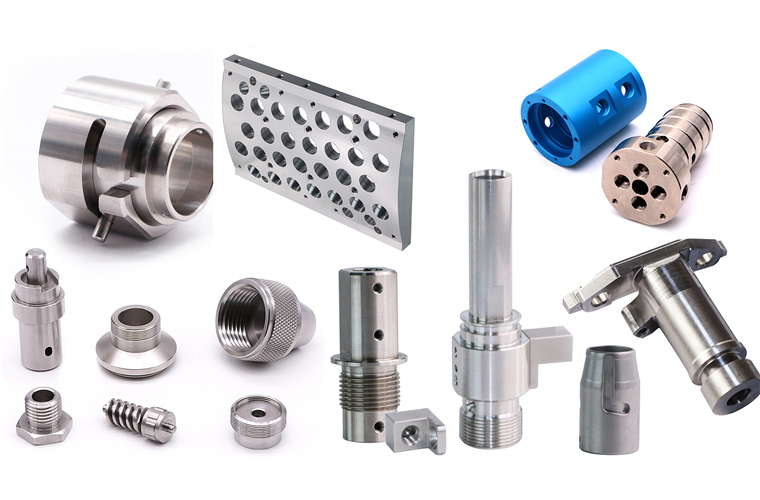15 years one-stop China custom CNC machining parts factory
 1311 |
Published by VMT at Aug 13 2024
1311 |
Published by VMT at Aug 13 2024
In the field of CNC machining and parts manufacturing, selecting the right steel material is crucial. Among the commonly used alloy steels, 4140 and 8620 each have distinct chemical compositions, physical properties, and applications. This article provides a detailed comparison of 4140 and 8620 steels, analyzing them from the perspectives of chemical composition, mechanical properties, machinability, heat treatment, and applications. This guide aims to serve engineers, designers, and material procurement professionals with a comprehensive reference.
The 41xx series steel belongs to the low-alloy, high-strength steel category, widely used in applications requiring high strength, toughness, and wear resistance. The addition of chromium, molybdenum, and manganese enhances the steel's hardenability and overall mechanical performance.
4140 steel, also known as 41CrMo4 or EN19, is a widely used medium carbon alloy steel. Its chemical composition primarily includes iron, carbon, chromium, molybdenum, and manganese, which together impart exceptional mechanical properties and machinability.

4140 steel contains approximately 0.40% carbon, along with 0.80-1.10% chromium, 0.15-0.25% molybdenum, and moderate amounts of manganese and silicon. This chemical design allows 4140 steel to achieve high hardness and good toughness after heat treatment.
High Tensile and Fatigue Strength: After heat treatment, 4140 steel can achieve tensile strengths of 758-965 MPa and exhibits excellent fatigue strength, making it suitable for dynamic loads.
Hardness and Ductility: Through quenching and tempering, 4140 steel can obtain high hardness while maintaining good ductility and impact toughness.
Corrosion Resistance: Although not a stainless steel, 4140 offers good corrosion resistance in general environments, making it versatile for various working conditions.
Weldability: 4140 steel is weldable but requires pre- and post-heat treatment to avoid cracking.
Machinability: In the annealed state, 4140 steel is easily machined into various shapes and sizes, making it ideal for CNC machining.
4140 steel is widely used in automotive, aerospace, heavy machinery, and mold manufacturing. Its high strength, toughness, and good machinability make it an ideal material for high-strength structural parts, transmission components, and molds.
8620 steel is a nickel-chromium-molybdenum alloy steel known for its good hardenability and machinability. It is classified as a low-carbon alloy steel and is commonly used for parts requiring carburizing.

8620 steel has a low carbon content of about 0.20%, along with 0.75-1.05% nickel, 0.30-0.50% chromium, and 0.15-0.25% molybdenum. This chemical design allows 8620 steel to achieve high surface hardness and core toughness after carburizing.
Hardness and Tensile Strength: After carburizing and quenching, 8620 steel's surface hardness significantly increases, while the core maintains good toughness. The tensile strength is also enhanced to meet high-strength requirements.
Mechanical Properties: 8620 steel exhibits good elasticity and ductility, making it suitable for complex stress and deformation.
Corrosion and High-Temperature Resistance: While not comparable to stainless steel or superalloys, 8620 offers good corrosion resistance and maintains stable mechanical properties within a certain temperature range.
Weldability: 8620 steel has good weldability and is suitable for various welding methods, but care must be taken to control heat input to avoid overheating.
8620 steel is widely used in automotive, engineering machinery, and gear manufacturing. Its low-carbon alloy design allows parts to achieve an ideal combination of surface hardness and core toughness after carburizing, making it especially suitable for gears, shafts, and other components subject to high contact stress and wear.
Advantages of 4140 Steel:
Disadvantages of 4140 Steel:
Advantages of 8620 Steel:
Disadvantages of 8620 Steel:
Element Composition: Both are alloy steels, but 4140 steel has a higher carbon content, while 8620 steel is a low-carbon alloy steel. Both add chromium and molybdenum to enhance mechanical properties, but 8620 steel also contains nickel to improve hardenability and toughness.
Corrosion Resistance: Both offer some corrosion resistance but are not stainless steels. In humid or corrosive environments, additional anti-corrosion treatment may be required.
Heat Treatment: Both can be heat-treated to improve mechanical properties. However, 4140 steel typically undergoes quenching and tempering to achieve high strength and toughness, while 8620 steel undergoes carburizing, quenching, and tempering to achieve an ideal combination of surface hardness and core toughness.
Mechanical Properties:
Strength and Toughness: 4140 steel excels in strength and toughness, making it suitable for high-stress and impact load conditions. 8620 steel can also achieve high surface hardness after carburizing, but its core toughness remains good.
Machinability: 8620 steel is easier to machine in the annealed state than 4140 steel, but both can be improved through appropriate heat treatment.
Weldability: Both have good weldability but require careful control of heat input and proper pre- and post-weld heat treatment measures.
Applications: Due to performance differences, 4140 steel is more suitable for high-strength and high-toughness applications such as automotive transmission parts and molds. 8620 steel is more suitable for carburized parts like gears and shafts.
When choosing between 4140 and 8620 steels, consider the following factors:
Element Composition: Choose the appropriate alloy element content based on the operating environment and performance requirements.
Mechanical Properties: Select steel with appropriate strength and toughness based on the stress conditions of the part.
Weldability: If the part requires welding, choose steel with good weldability and pay attention to welding process control.
Material Availability: Consider the availability and cost of both steels in the market.
Machinability: Choose the appropriate steel based on the complexity and difficulty of machining the part.
Confirm Heat Treatment Requirements: Understand and confirm the heat treatment process and performance requirements for the part.
Cost Consideration: Choose steel with the best cost-performance ratio while ensuring performance.

Cold Working/Strain Hardening: Both can be cold worked to increase hardness and strength, but the amount of work should be controlled to avoid excessive hardening and cracking.
Annealing: Annealing can eliminate internal residual stresses and structural defects in the steel, improving machinability.
Tempering and Quenching: 4140 steel typically undergoes quenching for high hardness, followed by tempering to adjust hardness and toughness. 8620 steel is first carburized, then quenched and tempered to achieve the desired combination of surface hardness and core toughness.
Normalization: For large or complex-shaped parts, normalization may be necessary to eliminate structural non-uniformity and residual stresses.

4140 steel and 8620 steel are two commonly used alloy steels, each with different characteristics and application fields.
Applications of 4140 Steel:
4140 steel is a medium-carbon, low-alloy steel known for its balance of high strength, hardness, and toughness. The addition of chromium and molybdenum enhances its wear resistance, heat resistance, and overall strength. The higher carbon content gives 4140 steel excellent hardness and strength but may reduce its ductility. It is commonly used in manufacturing gears, shafts, and other high-stress components, and is widely applied in the automotive, agriculture, oil and gas, aerospace, and marine industries.
Typical Applications of 4140 Steel:
4140 steel is a versatile steel alloy widely used in various applications. Here are some typical applications of 4140 steel:
Automotive Industry: 4140 steel is commonly used in automotive components such as gears, crankshafts, axles, and connecting rods. Its high strength, hardness, and wear resistance make it ideal for these critical parts that require durability and reliability.
Oil and Gas Industry: 4140 steel is utilized in the oil and gas industry for manufacturing drilling tools, drill collars, and other downhole equipment. Its excellent toughness, fatigue resistance, and ability to withstand high-pressure environments make it suitable for these demanding applications.
Aerospace Industry: In the aerospace sector, 4140 steel is used for manufacturing landing gear components, aircraft engine parts, and structural elements. Its high strength-to-weight ratio, corrosion resistance, and ability to maintain integrity under extreme conditions make it a preferred material in aerospace applications.
Machinery and Equipment: 4140 steel is commonly employed in the manufacturing of industrial machinery, hydraulic systems, and heavy equipment. Its toughness, hardness, and ability to withstand high loads and impact forces make it suitable for gears, shafts, and other critical components in machinery.
Tooling and Dies: 4140 steel is widely used for tooling and die applications, including molds, punches, and dies for metal forming processes. Its high hardness, wear resistance, and ability to retain sharpness make it an excellent choice for precision tooling.
Construction and Infrastructure: 4140 steel is utilized in construction and infrastructure projects for manufacturing structural components, such as beams, columns, and fasteners. Its high strength and durability make it suitable for withstanding heavy loads and ensuring the structural integrity of buildings and bridges.
Agricultural Equipment: In the agricultural sector, 4140 steel is used for manufacturing components of farming machinery, including plow blades, tractor parts, and harvesting equipment. Its toughness, wear resistance, and ability to withstand harsh operating conditions make it suitable for agricultural applications.
Applications of 8620 Steel:
8620 steel is a low-alloy steel containing nickel, chromium, and molybdenum, known for its high hardenability, wear resistance, and strength. This steel has good weldability, is not prone to cold cracking, and has good machinability and cold working plasticity. 8620 steel is commonly used for gears, shaft systems, bolts, nuts, and other parts requiring wear resistance and strength. It is mainly used in industries such as manufacturing, engineering, machinery, and automotive.
Typical Applications of 8620 Steel:
8620 steel is a low-alloy steel with excellent hardenability and wear resistance. Here are some typical applications of 8620 steel:
Gears and Pinions: 8620 steel is commonly used in the manufacturing of gears and pinions. Its high hardenability allows for effective case hardening, resulting in a hard outer surface and a tough core. This makes 8620 steel ideal for gears subjected to high loads and wear, such as those found in automotive transmissions, industrial machinery, and power tools.
Shafts and Axles: 8620 steel is used for shafts and axles in various applications, including automotive drivetrains, agricultural machinery, and industrial equipment. The combination of its wear resistance and toughness makes it suitable for components that require high strength and durability under rotational and bending loads.
Bolts and Fasteners: 8620 steel is utilized in the production of bolts, nuts, and other fasteners that require high strength and resistance to wear and fatigue. Its good machinability and ability to be case-hardened make it a popular choice for critical fasteners used in automotive, construction, and heavy machinery industries.
Bearing Components: 8620 steel is used in the manufacturing of bearing components such as races, rollers, and cages. Its ability to achieve high hardness through case hardening, combined with good toughness, makes it suitable for bearing applications that demand resistance to wear and fatigue.
Bushings and Sleeves: 8620 steel is employed in the production of bushings and sleeves for various applications, including automotive suspension systems, hydraulic cylinders, and industrial machinery. Its wear resistance and toughness make it ideal for components that experience sliding or rotational movement under load.
Crankshafts: 8620 steel is used for manufacturing crankshafts in engines and industrial equipment. The steel's hardenability and strength make it suitable for withstanding the dynamic forces and stresses experienced by crankshafts during operation.
Mining and Construction Equipment: 8620 steel is utilized in the production of components for mining and construction equipment, including excavator parts, bulldozer tracks, and crusher jaws. Its combination of wear resistance and toughness ensures the longevity and performance of these heavy-duty components.
When comparing 4140 and 8620 steel, it is essential to consider not only the mechanical properties and performance characteristics but also the cost and supply chain factors. These considerations play a crucial role in determining the feasibility and practicality of using a particular steel grade for a specific application. Here are some key factors to consider:
1. Material Cost:
4140 Steel: Generally, 4140 steel is more expensive compared to 8620 steel due to its higher carbon and alloy content. The cost is influenced by factors such as the steel's mechanical properties, heat treatment requirements, and the complexity of the manufacturing process. However, the higher cost of 4140 steel may be justified by its superior strength, toughness, and wear resistance in critical applications.
8620 Steel: 8620 steel is typically more cost-effective than 4140 steel, making it an attractive option for applications where cost is a significant consideration. Its lower carbon content and alloying elements contribute to its affordability while still providing good performance characteristics, especially after carburizing.
2. Availability and Supply Chain:
4140 Steel: 4140 steel is widely available and commonly used in various industries. Its popularity ensures a consistent supply chain with a range of product forms, including bars, plates, and forgings. The steel is readily available from steel distributors and suppliers, making it easy to source for most applications.
8620 Steel: 8620 steel is also readily available, especially in markets where carburizing steel grades are in demand. It is commonly stocked by steel suppliers and is available in various forms, such as bars, tubes, and billets. The steel's availability may vary depending on the region and the specific requirements of the application.
3. Machining and Processing Costs:
4140 Steel: Machining and processing costs for 4140 steel can be higher due to its higher hardness and strength. Special tooling, cutting speeds, and coolant may be required to achieve desired machining results. Additionally, heat treatment processes such as quenching and tempering add to the overall cost.
8620 Steel: 8620 steel is generally easier to machine in its annealed state, which can result in lower machining costs. However, the additional carburizing process required to achieve desired surface hardness adds to the processing cost. The overall cost-effectiveness of 8620 steel depends on the specific application and required performance characteristics.
4. Lead Time and Production Planning:
4140 Steel: The lead time for 4140 steel products is typically reasonable, given its widespread use and availability. However, the need for heat treatment processes may extend the overall production timeline.
8620 Steel: The lead time for 8620 steel products may be shorter for standard sizes and forms. However, the additional time required for carburizing and subsequent heat treatment should be factored into production planning.
5. Total Cost of Ownership:
4140 Steel: While the initial material cost of 4140 steel may be higher, its superior mechanical properties and durability can result in a lower total cost of ownership over the life of the component. This makes it a cost-effective choice for high-performance applications.
8620 Steel: 8620 steel offers a good balance of cost and performance, especially for applications requiring carburized surfaces. Its lower initial material cost, combined with adequate performance, makes it a practical choice for many industrial applications.
In conclusion, the decision between 4140 and 8620 steel should consider not only the material's mechanical properties and performance characteristics but also the cost, availability, and supply chain factors. By carefully evaluating these considerations, manufacturers can make informed decisions that optimize both performance and cost-effectiveness for their specific applications.
CNC machining is a precision manufacturing process that involves the use of computer-controlled machines to remove material and create intricate parts and components. When machining alloy steels like 4140 and 8620, it is essential to follow best practices to achieve the desired dimensional accuracy, surface finish, and mechanical properties. Here are some best practices for CNC machining 4140 and 8620 steel:
1. Tool Selection:
Carbide Tools: Both 4140 and 8620 steels benefit from the use of carbide tools due to their hardness and wear resistance. Carbide tools maintain sharp cutting edges and are ideal for high-speed machining of alloy steels.
Coated Tools: Consider using coated tools, such as titanium nitride (TiN) or titanium aluminum nitride (TiAlN) coated tools, to enhance tool life and reduce friction during machining. Coated tools are particularly effective when machining hardened or heat-treated 4140 steel.
2. Cutting Parameters:
Cutting Speed: For 4140 steel, use moderate cutting speeds to prevent excessive heat buildup and tool wear. For 8620 steel, especially in its annealed state, higher cutting speeds can be used for efficient material removal.
Feed Rate: Use appropriate feed rates based on the steel's hardness and the desired surface finish. Higher feed rates can be used for roughing operations, while lower feed rates are recommended for finishing passes.
Depth of Cut: Consider the material's hardness when selecting the depth of cut. For harder 4140 steel, shallow cuts may be necessary to prevent tool deflection and ensure dimensional accuracy. For 8620 steel, deeper cuts can be used, especially in the annealed state.
3. Coolant and Lubrication:
Flood Coolant: Use flood coolant to dissipate heat and reduce friction during machining. This helps to prevent workpiece deformation, tool wear, and surface damage. Flood coolant is particularly important when machining heat-treated 4140 steel.
Lubrication: Ensure proper lubrication during drilling and tapping operations to reduce friction and extend tool life. Lubrication also aids in chip evacuation and prevents chip welding.
4. Workpiece Clamping and Fixturing:
Secure Clamping: Ensure that the workpiece is securely clamped to prevent movement or vibration during machining. This is especially important when machining long or thin parts that may be prone to deflection.
Fixturing: Use custom fixturing or vises to hold irregularly shaped workpieces or to achieve precise alignment. Proper fixturing is crucial for maintaining dimensional accuracy and surface quality.
5. Heat Treatment Considerations:
Pre-Machining Heat Treatment: For 4140 steel, consider performing rough machining operations before heat treatment to remove excess material. This reduces the risk of dimensional changes during heat treatment.
Post-Machining Heat Treatment: For 8620 steel, carburizing and heat treatment can be performed after machining to achieve the desired surface hardness. Ensure that the workpiece is adequately supported to prevent warping during heat treatment.
6. Chip Control:
Chip Breakers: Use chip breakers on cutting tools to control chip formation and prevent long, stringy chips that can interfere with machining operations. Proper chip control is essential for maintaining tool life and preventing damage to the workpiece.
Chip Evacuation: Ensure efficient chip evacuation to prevent chips from accumulating in the cutting zone. This can be achieved through the use of high-pressure coolant or air blast systems.
7. Surface Finish and Tolerances:
Finishing Passes: Use finishing passes with lower feed rates and shallower depths of cut to achieve the desired surface finish and tight tolerances. This is especially important for critical components requiring high precision.
Surface Treatments: After machining, consider applying surface treatments, such as nitriding or coating, to enhance wear resistance and corrosion protection.
8. Quality Control:
Inspection: Implement rigorous quality control measures, including dimensional inspection, surface finish analysis, and hardness testing, to ensure that the machined parts meet the required specifications.
Process Monitoring: Continuously monitor machining parameters, tool wear, and coolant levels during production to maintain consistent quality and prevent defects.
In summary, CNC machining of 4140 and 8620 steel requires careful consideration of tooling, cutting parameters, coolant, and workpiece handling. By following these best practices, manufacturers can achieve high-quality machined parts with the desired mechanical properties and surface finish.
As a professional CNC machining parts manufacturer, VMT boasts advanced CNC machining equipment and extensive processing experience. We provide one-stop services, ranging from material selection and machining design to finished product delivery, ensuring that every customer receives high-quality CNC machined parts made from 4140 and 8620 steel. Our services cover custom CNC machining, CNC prototyping, and large-scale CNC machining, meeting your diverse processing needs.

In summary, 4140 and 8620 steels exhibit significant differences in chemical composition, mechanical properties, machining characteristics, and application fields. The choice between these materials depends on specific engineering requirements, cost considerations, and machining conditions. 4140 steel, with its high strength, toughness, and excellent overall mechanical properties, performs exceptionally well in situations that require resistance to high stress and complex loads. On the other hand, 8620 steel, with its good carburizing properties, lower carbon content, and excellent machinability, is the ideal choice for manufacturing gears, shafts, and other transmission components.
In the CNC machining field, quality service providers like VMT can offer professional machining services for both of these steel grades, ensuring that the machined parts meet customers' precise needs and performance standards. Whether it’s custom CNC machining, CNC prototyping, or large-scale CNC machining services, VMT leverages advanced equipment and extensive experience to provide customers with efficient and precise solutions.
What is 4140 steel equivalent to?
4140 steel is often referred to internationally as 41CrMo4 or EN19, which have similar chemical compositions and mechanical properties.
What is the Chinese equivalent of 8620 steel?
In China, 8620 steel is equivalent to 20CrNiMo steel under the GB/T standard, with comparable chemical composition and performance.
What grade is 8620 steel equivalent to?
8620 steel does not have a direct equivalent grade. It is a specific alloy steel designation, with its performance and application range determined by its chemical composition and heat treatment process.
What are alternatives to 8620 steel?
Alternatives to 8620 steel may include other low-carbon alloy steels, such as 20CrMnTi, which can achieve similar properties after carburizing. The specific choice depends on the part's requirements and operating environment.
What is the difference between 8620 and 4130 steel?
Both 8620 and 4130 are alloy steels, but they differ in chemical composition and properties. 8620 contains nickel, which enhances hardenability and toughness, while 4130 contains chromium and molybdenum for increased strength and hardness. Additionally, 8620 is typically used for carburizing to achieve a hard surface, while 4130 is often quenched and tempered for high strength and toughness.
What is the Rockwell hardness of 8620 steel?
The Rockwell hardness of 8620 steel, after carburizing, quenching, and tempering, can reach high values, depending on the carburizing depth, quenching temperature, and tempering temperature. Generally, the surface hardness after carburizing can reach HRC58-62.
What is the European equivalent of 8620 steel?
8620 steel does not have a direct European equivalent, but its chemical composition and properties are similar to some European standard alloy steels. When selecting alternative materials, it is important to carefully compare chemical composition, mechanical properties, and heat treatment processes.
What material is stronger than 4140 steel?
There are many materials stronger than 4140 steel, such as high-strength alloy steels, stainless steels, titanium alloys, and certain special alloys. The choice of material depends on specific engineering requirements, cost considerations, and material availability.
What is 8620 steel used for?
8620 steel is suitable for transmission components that require carburizing, such as automotive gears and shafts. Its low-carbon alloy design allows parts to achieve an ideal combination of surface hardness and core toughness after carburizing, meeting the demands for high strength and wear resistance.
